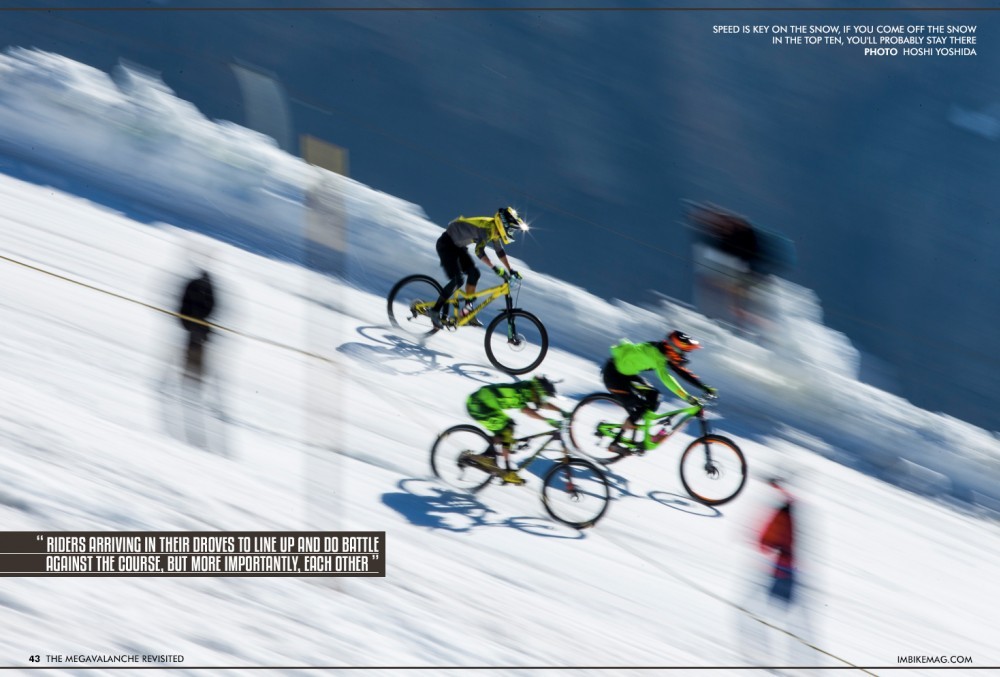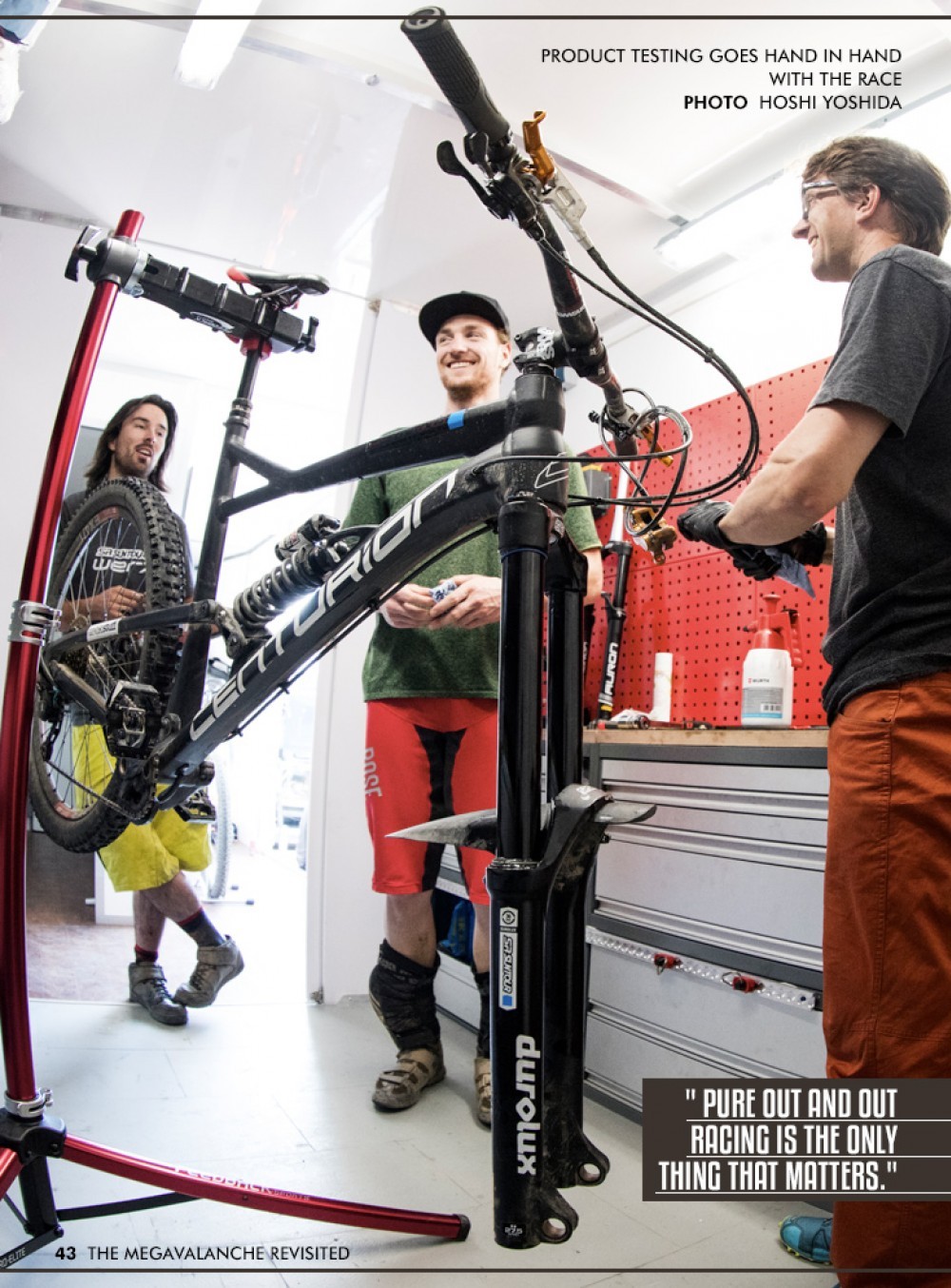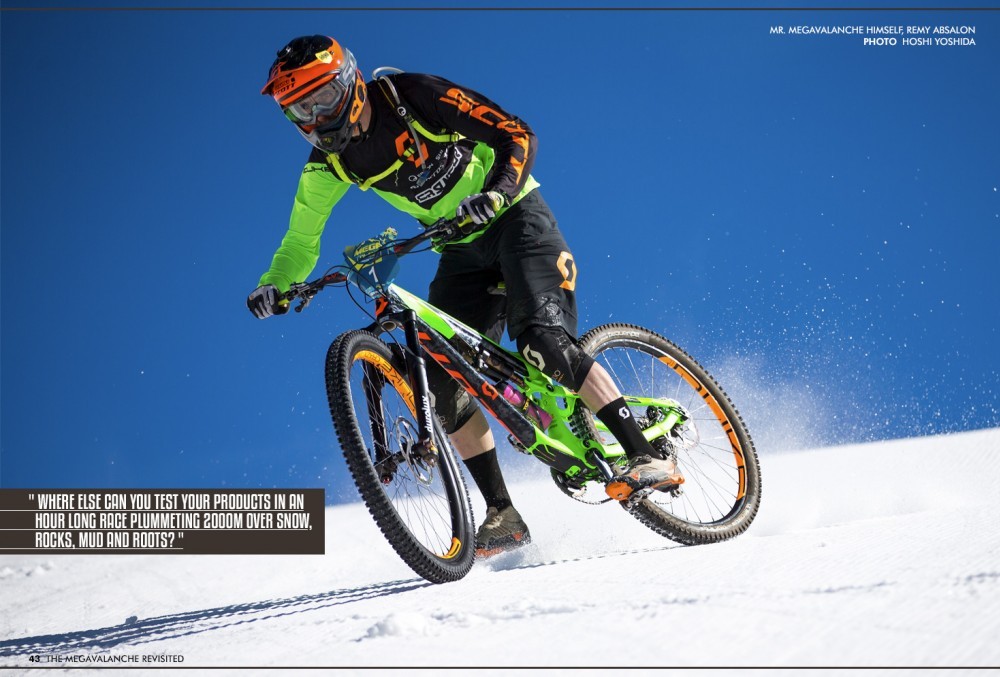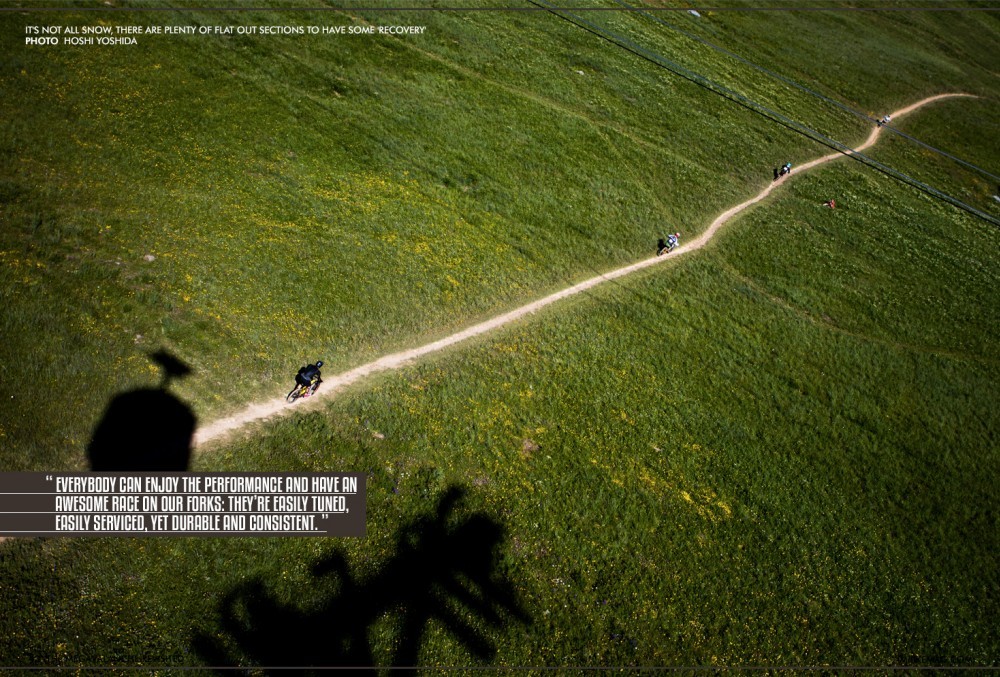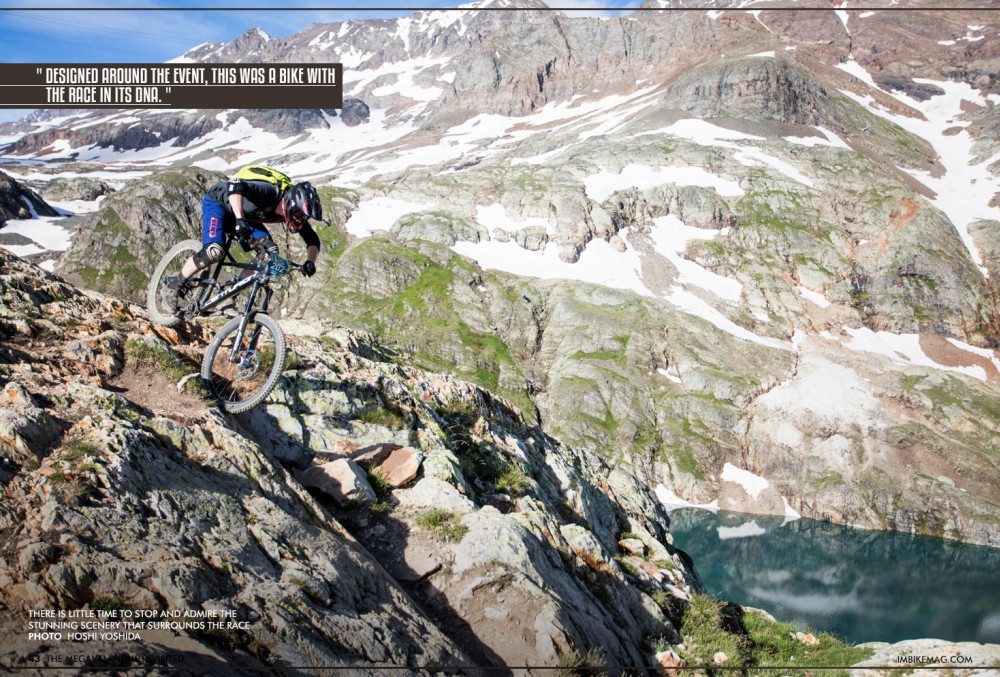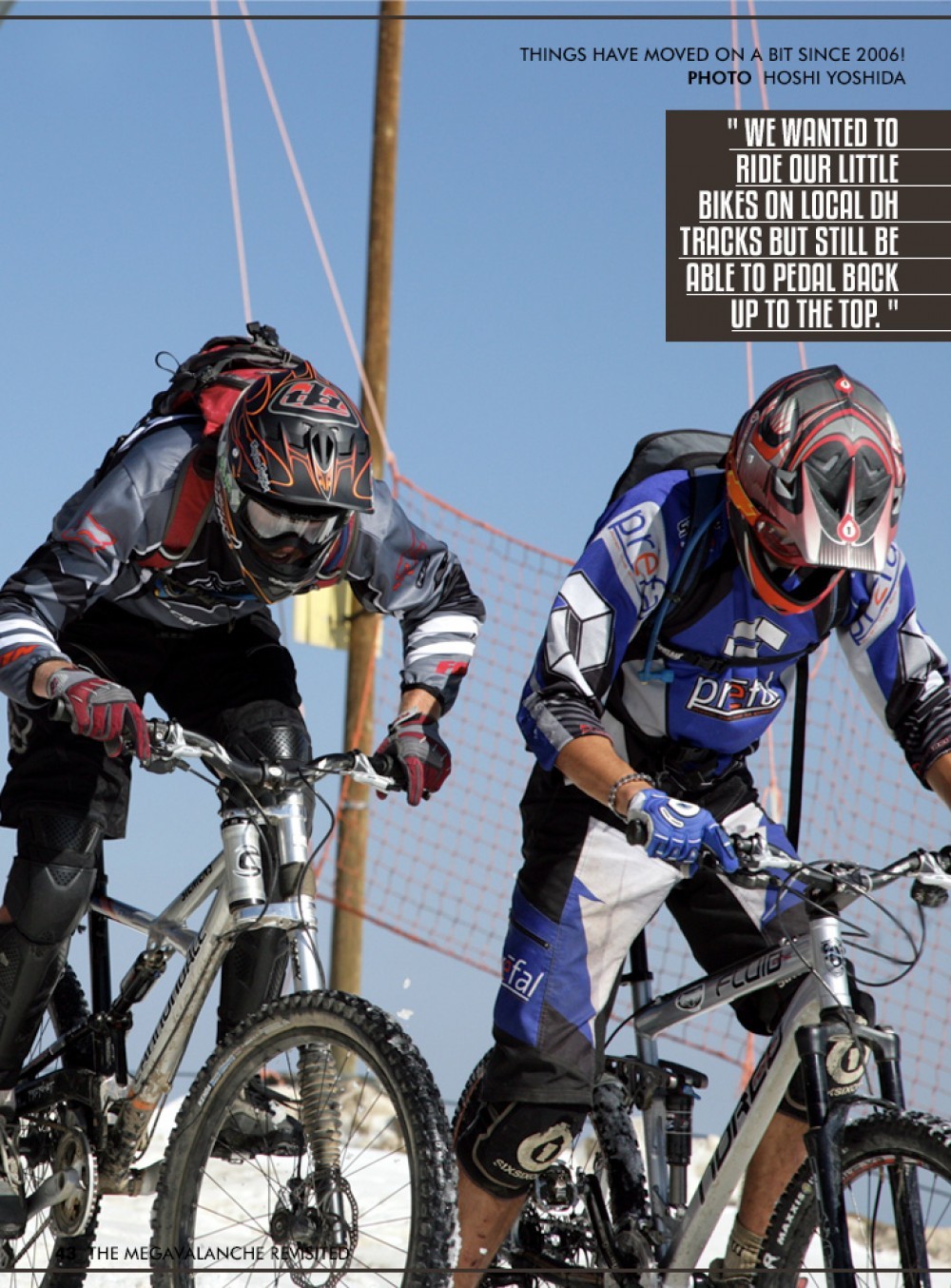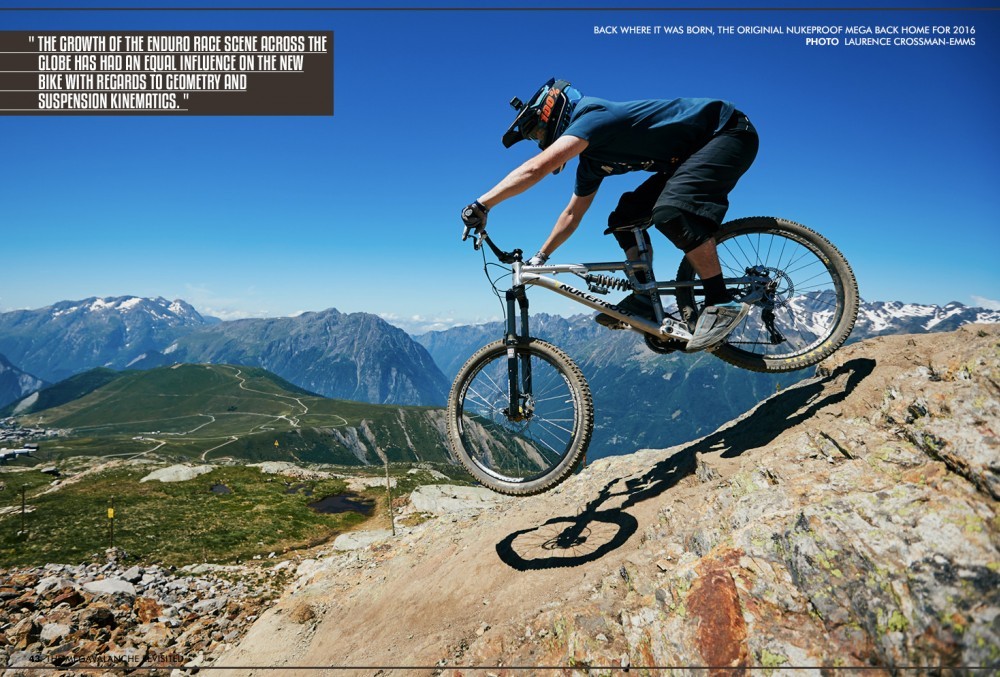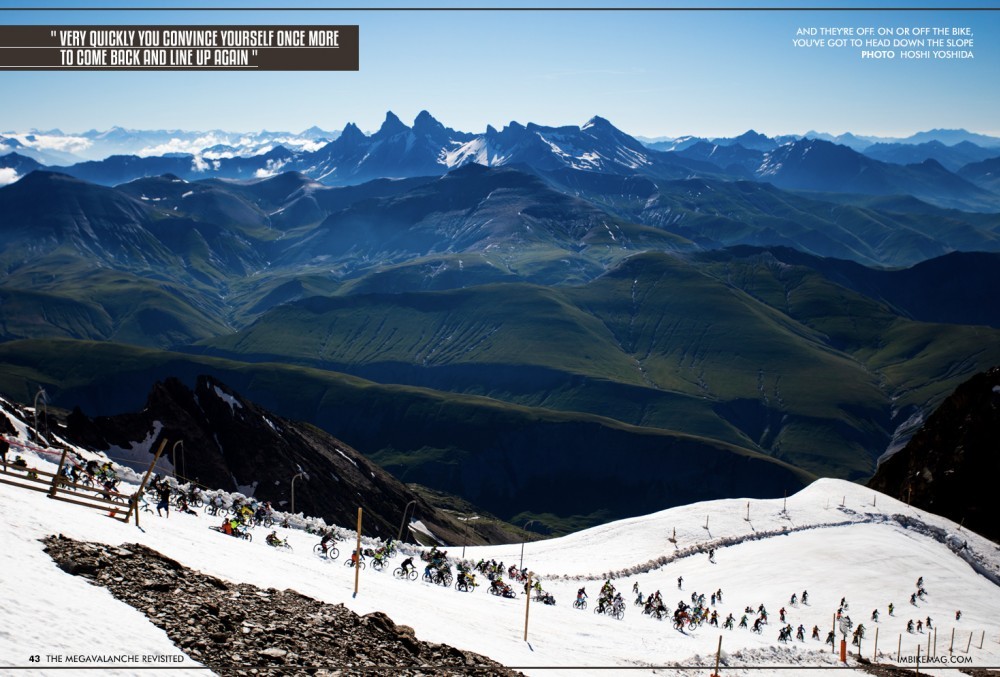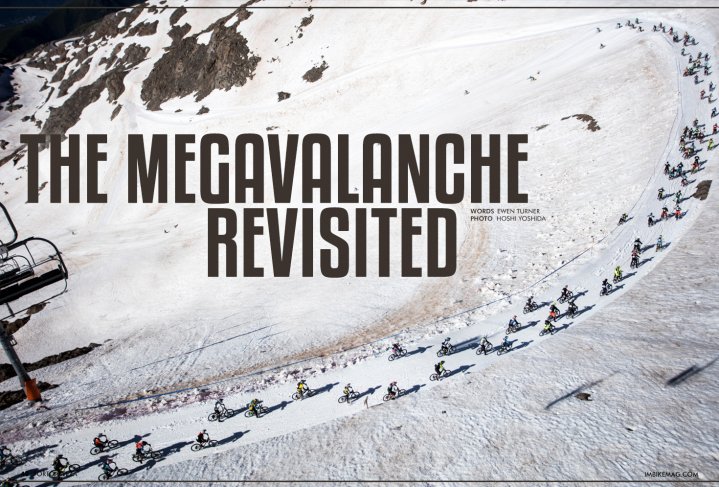
The Megavalanche Revisited
Issue 43 / Mon 22nd Aug, 2016
We join the hoards in the annual pilgrimage to Alpe d'Huez to do battle with the Megavalanche. While there we catch up with SRSuntour and Nukeproof to find out just how important this race is to them as they develop products designed to excel in this harsh environment.
Ewen Turner heads out to the fabled trails of Alpe D’Huez to race down Pic Blanc in the most famous MTB race in the world. He asks the questions, is the Megavalanche still relevant and is it still driving product development like it used to?
Alarma!
The sirens, the helicopter, the euro-tech music, the snow, the fear. This sensory overload will ring true for anyone who has lined up at the Megavalanche, a race so well known that even non-bikers seem to have heard of 'that crazy ride in the snow'. Since 1995 there has been an annual pilgrimage to Alpe d'Huez, with riders arriving in their droves to line up and do battle against the course, but more importantly, each other as they plummet from Pic Blanc down to Allemond.
Back in 1995 Enduro hadn't been born, and even the French wouldn't get properly going with the format until the next decade. Back then the Mega was perhaps the closest thing to an Enduro style race, rewarding speed, technique and fitness in equal measure. This alternative style of racing obviously struck a chord with riders, as numbers year on year continued to rise, with 1,800 participants seen at this year's race.
These days the geographical spread of riders is clear, with French, British and German riders making up the majority of the pack. In fact, as a 'Brit abroad' at the Mega, it can feel an awful lot like a weekend at the races in the UK, passing familiar faces through the streets of Alpe d'Huez. This familiarity and friendly vibe is perhaps one of the reasons the race is so successful. There is no doubt the riding is tough and the course is long, but it is also accessible to anyone on a bike who fancies their chances against the slopes of Pic Blanc.
The practise days allow for nerves to be settled and figure out how to ride the snow, while the qualifying races makes sure riders end up in an appropriate place for the final. However, once the music starts and the tape is lifted, all bets and allegiances are off, pure out and out racing is the only thing that matters. Elbows out, full speed, total commitment.
The Mega Effect
The Megavalanche has had a huge hand in the development of mountain bike racing as we know it. Not only in creating other mass-start events, but also with the rise of enduro as the Mega represented the appetite for something different from Downhill and XC. If the event has had a huge effect on the type of racing available, then it's effect on technological development has been even greater.
Where else can you test your products in an hour long race plummeting 2000m over snow, rocks, mud and roots? Sure you can create these conditions elsewhere, but nothing tests technology like racing and the product developers know this. Take a trip to YouTube and find the early race footage and just see how far things have come.
Take SRSuntour for instance, who have been involved in the Mega for 11 years, and have used it as a testing ground for their products year on year. Christoph Boesl from SRSuntour tells me they started to sponsor the event back in 2004 and 'Back then we did not have any forks dedicated for the Megavalanche, but we had a vision'. This vision is about developing great products for all riders, pros and amateurs alike, after all, they all have to get to the bottom of the mountain.
“The Megavalanche is an event that is open to all ages and all kinds of riders, from amateur to pro, from young people to seniors. The joy to ride is the unifying moment, and that’s where SRSUNTOUR sees its potential as one of the biggest suspension suppliers in MTB. The SRSUNTOUR philosophy is to make race proven technology accessible for all of us; this means making refined technology user-friendly. 12 years later in 2016, we have won the Megavalanche two times in a row. We’ve had ten riders in the first starting row. With our pro-athletes program WERX, we have developed forks to win the Megavalanche. But the products are still based on the same Quick Service Product (QSP) philosophy from back in the day.
Everybody can enjoy the performance and have an awesome race on our forks: They’re easily tuned, easily serviced, yet durable and consistent. The history of the partnership with the Megavalanche is congruent to the product development at SRSUNTOUR. Our target to win the Megavalanche one day came from the same objective as creating a fork everybody can enjoy the race with.” - Christoph Boesl- SRSuntour
If we think about what we now demand from our products, it would be unheard of back in the early days of the race. Single crown air sprung forks with up to 180mm of travel, dropper posts, carbon frames, disc brakes that don't overheat or explode, essentially trail bikes that would have won downhill world cups 10 years ago. For SRSuntour, riding high on Remy Absalon's win in 2015, they even released a Mega Edition fork, further cementing their relationship and commitment to the race.
“The driving force behind the suspension development for the Megavalanche, of course, was Remy Absalon. We wanted to create a fork he can win with. After two years of development Remy finally won the 2015 Megavalanche on his AURON 29“ RC2 PCS. At that time he was testing the new piston compensator technology called PCS.
The 30km long descent was predestined for the ultimate durability test. Hydraulic systems have a hard time on such long and tough descents with over-heating cartridges and cavitation in the piston chamber cause emulsion of air and oil, which leads to a loss of damping performance. The PCS cartridge helped win the Mega 2015 and made it into the production model, introduced by the AURON RC2 PCS Megavalanche Edition.” - Christoph Boesl- SRSuntour
Megas at the Mega
If we talk about technological developments, we cannot overlook the race's namesake bike; the Nukeproof Mega. These days bikes like this are everywhere, under the guise of enduro, trail or the all-mountain label, but back then it was definitely something new. Designed around the event, this was a bike with the race in its DNA. Coming in as a 150mm bike capable of handling a 170mm fork, with progressive geometry, it was a bike that would excel on this course. At a time when some riders were still using downhill bikes and suffering on the climbs, this was a significant step forward, and, as a by-product, created a bike you could ride all day, both up and down hill. This year saw a return of the original prototype to the Mega, along with the latest generation of the same bike and the designer Dale McMullen, who told me how the initial bikes came about:
“Bikes at the time didn’t quite suit the style of riding that we were interested in at that point. Coming from a DH background, we wanted to ride our little bikes on local DH tracks but still be able to pedal back up to the top. (There were no uplifts available in Ireland until recently.) We added longer travel forks, wider bars, shorter stems and heavier tyres to our short travel bikes at the time, and soon realised we could do a better job by making our own frame with DH geo, shorter travel and lighter weight.
Having the first Mega prototype frame arriving just in time for the 2009 Megavalanche race was always the goal, and it was definitely a real test for the new frame! We had two prototype versions really. Michael Cowan rode the first one in 2009, came home with cracks on the chain stay and then I rode it in 2010 with an upgraded chain stay where I crashed in the Main race and broke my elbow!” - Dale McMullen- Nukeproof
The Mega is still a race to test bikes to the limit, and if the kit can survive the drop to Allemond, then it's good enough for the toughest of demands. The rise of enduro has given designers even more challenges, and riders are always demanding more from their bikes.
We asked Dale if the Megavalanche was still relevant to modern riders and bikes? Also, what of the new Nukeproof Mega, has the original race still played a part in its development?
“Yes it has, but likewise, the growth of the Enduro race scene across the globe has had an equal influence on the new bike with regards to geometry and suspension kinematics. If you compare the original Mega frame with this latest version, there are some very significant updates which we believe reflect the needs of the modern rider/racer as well as the hundreds of Brits that make the pilgrimage to Alpe D’ Huez each year.” - Dale McMullen
The Megavalanche 2016
This year's race was won by Mr Mega himself Remy Absalon, a man with an incredible history on this course. It was even more impressive this year, due to the number of pros on the lineup, including a who's who of mountain biking including Cedric Gracia, François Bailly-Maître and Matti Lehikoinen. The women's race was equally stacked with a strong field including the dominant force that is Cécile Ravanel alongside the eventual winner Pauline Dieffenthaler and up and coming privateer Bex Baraona.
For myself I had a score to settle, having had first-hand experience of how hard this course is on equipment. Two previous attempts saw me puncturing in the qualifier the first year, then the second year I suffered a destroyed rear mech; followed rapidly by a broken frame. These mechanical issues had me missing the final both times, and I was keen to get lined up on the snow for a proper Mega experience.
This year the stars aligned (or maybe experience and knowledge prevailed) and a front row start for the qualifier had me finish high enough for a fourth-row start in the final rubbing shoulders with the best of the best. The final battle commenced and 400 riders battled around me on the soft snow as we fought to gain traction, grip, or really any vague idea of control. After an hour, and 2000m of descent, we are spat out through the finishing gate and collapsed on the floor.
Many vow never to come back, proclaiming mechanicals, injuries or unjust overtaking manoeuvres. I know, however, by the time riders have returned home, they still have the intensity of the race experience imprinted in their brains, and very quickly you convince yourself once more to come back and line up again on the snowy slopes of Pic Blanc. This is truly a one of a kind race!
Why Not You?
This is one race all mountain bikers should try to experience. Yes, it's scary, but never quite as terrifying, once you get on with the riding and the racing, the thought of it is always worse. If you have some experience of alpine or big mountain riding, then go for it. It's definitely not buff smooth berms and rollers, but neither is it prohibitively difficult for a competent rider. The snow is hard to ride but great fun, and rest of the course is rocky, rough and challenging, but with no death-defying drops and jumps. The majority of the course can be ridden 'wheels on the ground' it is certainly within the realms of most riders.
Every rider should have at least one Mega race plate in their shed, What are you waiting for?
Special thanks too:
For part of our trip to the Megavalanche, we stayed with Peak Adventures at their Chalet Saskia, where our minds were blown by the incredible food and accommodation. This is in Vaujany, easily accessible to the main trails of Alpe d'Huez via an awesome cable car, and a great place to see the area. Check them out here: http://www.peak-adventures.net/our-accommodation/chalet-saskia
Videos
By Ewen Turner
Ewen Turner is a self-confessed bike geek from Kendal in the Lake District of England. He runs a coaching and guiding business up there and has a plethora of knowledge about bikes with an analytical approach to testing. His passion for bicycles is infectious, and he’s a ripper on the trails who prefers to fit his working life around his time on the bike.



